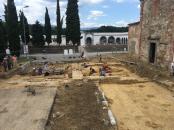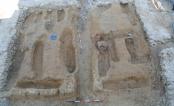CAMPAGNA 2018 |
1° SETTIMANA |
2° SETTIMANA |
3° SETTIMANA |
4° SETTIMANA |
5° SETTIMANA |
6° SETTIMANA |
7° SETTIMANA |
8° SETTIMANA |
9° SETTIMANA |
19 GIUGNO 2018 
Resoconto della giornata di scavo
Area 3000
Anche quest’anno, come nelle ultime campagne di scavo, le indagini si concentreranno all’intero del Settore B, con lo scopo di continuare ad approfondire i livelli cimiteriali riferibili alla frequentazione della chiesa di XI secolo. In particolare dopo un’accurata pulizia generale del settore, sono stati individuati i limiti di alcuni tagli di forma allungata, perlopiù orientati W-E: US – 3887, nella porzione sud-orientale; US – 3895 e US – 3897 nella porzione nord-occidentale e US – 3901 nella porzione centro-settentrionale. I rispettivi riempimenti saranno rimossi nel corso della giornata di domani.
We finished cleaning the south side of Section B. We proceeded then to remove excess sediment from Area 3000, moving from west to east in direction of the previously discovered graves. Two possible grave sites were identified. On the western side of the central trench, we found bone fragments and holes indicating a potential grave. The second potential burial was found along the east wall on the north side. South of the trench, a change in sediment indicated a possible circular structure which is older than the 11th Century. Metals slags were also uncovered in the trench and in the burial pits east of the bell furnace. A potential reduction was identified in the cleaning process towards the south wall. There was a mostly articulated skeleton with several other scattered skeletal remains within the pit. The site was then prepped for further exaction using a water hose.
Area 5000
Today we continued in two groups. The group that was in the sectioned off corner continued cleaning out the backfill dirt to get to the previous year’s level. In doing this a frontal bone, several post-axial bones, a few teeth, and pottery shards were uncovered. As we got closer to the layer several more bones were found as well as a coin which was deemed the first special find of 2018. In the other section we finished cleaning off the paleosurface. It was dampened by a hose to look for differences in color and a picture of it was taken. Then in part of the area a few centimeters were removed to expose the layer beneath the current one to assess it for further excavation.
Area 6000
Today began with a lecture on stratigraphy (but for some, at the airport) . Here, we went over the basics on the topic and how to differentiate strata in different context. Following this, we proceeded to the field site and continued with brushing and carefully troweling the spaces in between the stone wall. Once we continued moving down the area, several sets of remains were visible on the surface, many out of context. These out of context pieces were placed in a plastic bone bag. We also brushed loose dust from the bones on the surface. Once we completed the cleaning process, and cleared the trench of hay, we carefully brushed loose debris from the more out-of-context bone fragments and collected them. Our supervisor watered down area 6000 in order to tamp down the dust and few the color changes in the rock and sediments. Examples of what we found include; isolated teeth, cranial fragments (believed to be part of the frontal and/or parietal(s) as well as a frontal bone fragment with the superciliary arch and what we believe might be a frontal sinus , several long bone fragments.












